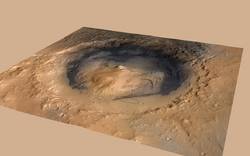
| MISSION |
|
Curiosity's Landing Site: Gale Crater
At 10:32 p.m. PDT on Aug. 5, 2012 (1:32 a.m. EDT on Aug. 6, 2012), the Mars Science Laboratory rover, Curiosity, landed on Mars at 4.5 degrees south latitude, 137.4 degrees east longitude, at the foot of a layered mountain inside Gale Crater. The crater is named for Australian astronomer Walter F. Gale (1865-1945). Gale Crater formed when a meteor hit Mars in its early history, about 3.5 to 3.8 billion years ago. The meteor impact punched a hole in the terrain. The explosion ejected rocks and soil that landed around the crater. Scientists chose Gale Crater as the landing site for Curiosity because it has many signs that water was present over its history. Water is a key ingredient of life as we know it. Minerals called clays and sulfates are byproducts of water. They also may preserve signs of past life--if it existed, that is! The history of water at Gale, as recorded in its rocks, will give Curiosity lots of clues to study as it pieces together whether Mars ever could have been a habitat for small life forms called microbes. Gale is special because we can see both clays and sulfate minerals, which formed in water under different conditions. Gale Crater spans 96 miles (154 kilometers) in diameter and holds a mountain (which is informally named "Mount Sharp" to pay tribute to geologist Robert P. Sharp) rising higher from the crater floor than Mount Rainier rises above Seattle! Gale is about the combined area of Connecticut and Rhode Island. Curiosity landed within a landing ellipse approximately 4 miles wide and 12 miles long (7 kilometers by 20 kilometers). The landing ellipse is about 14,400 feet (4,400 meters) below Martian "sea level" (defined as the average elevation around the equator). The expected near-surface atmospheric temperatures at the Gale Crater landing site during Curiosity's primary mission (1 Martian year or 687 Earth days) are from - 130 F to 32 F (-90 C to 0 C). Layering in the central mound (Mount Sharp) suggests it is the surviving remnant of an extensive sequence of deposits. Some scientists believe the crater filled in with sediments and, over time, the relentless Martian winds carved Mount Sharp, which today rises about 3.4 miles (5.5 kilometers) above the floor of Gale Crater--three times higher than the Grand Canyon is deep! News releases about Gale Crater:
|


